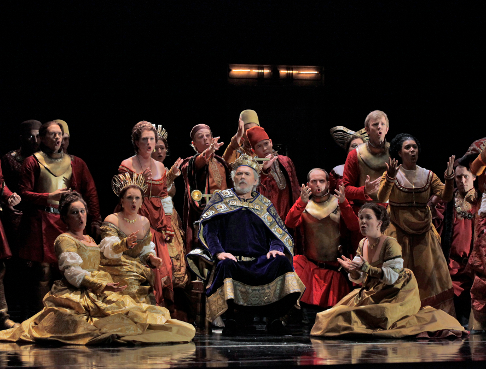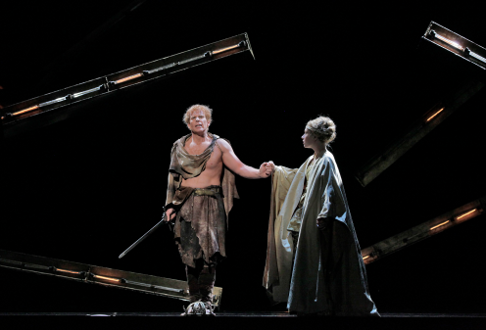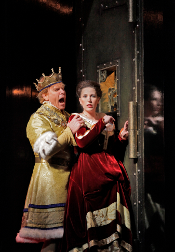26 Jul 2010
Santa Fe’s Mixed Dreams
Fairy Tales are often short on character, motivation and development. The stock figures are either good or bad, they are usually archetypal, and stand not only for themselves but larger dimensions of humanity.

Fairy Tales are often short on character, motivation and development. The stock figures are either good or bad, they are usually archetypal, and stand not only for themselves but larger dimensions of humanity.
They tend, thus, to be simplistic and easily understood by children. They also tend to be tricky sources for writing effective opera.
When used as the text for an opera, which sometimes can be effectively done, as in Engelbert Humperdinck’s wonderful Hansel and Gretel, it is the musical score that makes the work successful. All the blank spaces are filled in and emotion is established by the music. If this does not happen — trouble.
Trouble is what Santa Fe Opera had plenty of in mounting the never-before-staged 1978 opera, Life is a Dream, by (now retired) Amherst professor of music, composer Lewis Spratlan. The composer was on hand in Santa Fe for the opera’s rehearsal period and generously conducted symposia and gave interviews, and he let it be known that we were all in for a treat with Life is a Dream.
In a way, we were. Visually! The set is a most ingenious array of lighted barrier gates — think of the ‘arms’ that descend over a road at railroad crossings. A score of such members, fitted out with incandescent light tubes, would swing down or up from stage right and left, on visible ‘gears,’ comic strip version, providing all sorts of moods and meanings. We were in a forest so they were tree limbs; our characters were in danger so they could hide behind the barriers and be safe, we needed a ceiling, so all the light-arms ascended to the top of the stage and formed a pleasing ‘ceiling’ and source of light for the action below. If we needed a mood change, the tubes of warm light could grow cooler, or less or more intense. It was tremendously impressive and innovative, and my hat is off to scenic designer David Korins and lighting designer Japhy Weidman, as well as over-all stage director Kevin Newbury, who enjoyed nothing less than a triumph with their concept of mis-en-scène.
The evening also benefitted from Jessica Jahn’s elegant formal costumes of, I suppose, the era of the opera’s dramatic source, Pedro Calderón de la Barca’s 16th Century play, La Vida es Sueño (libretto adaptation by James Maraniss). A major stage element was a curiously Dada-esque (think Marcel Duchamps) ‘tower’ that rose from the stage floor, all round and mechanical and metallic with strong doors that contained the wild and dangerous son of King Basilio who had to be exiled to a forest, kept from society, and from endangering the King. The tall tower, on occasion, would move lower into the stage floor and become a throne, with amusing rather faux-Land of Oz lighting, and sometimes it would disappear entirely to make room for the King’s court. It was all great visual fun. Bravo!
 John Cheek as King Basilio and Chorus
John Cheek as King Basilio and Chorus
Meanwhile, back at the forest, the wild and crazy boy, Segismundo, is now a grown up Prince, though he does not know it. But the King, old and near death, is having second thoughts, and risks bringing the boy in from the cold to test him out as a functioning Heir (though the ambitious Duke Astolfo aspires to the throne). Alas, young Seggie does not pass the test, for he throws an unsatisfactory servant off a balcony in to the sea, and engages in further unpleasantness. Back he goes to the tower in the forest — where a few more things happen, and whether dreaming or not dreaming, the Prince vows to behave himself and be a good monarch, while all rejoice. Yep, a happy ending. Interestingly enough, vocal music is abandoned for the final climactic lines of the play/opera and the words are clearly spoken by our reformed hero, a quite clever device for they could be heard and understood.
Now we come full circle: Spratlan’s opera did not convince me for several reasons, quite aside from the simplistic tale whence it springs. First among the problems is a cerebral, if sometimes witty, score that bears no lyric material whatsoever. Virtually all vocal writing is spiky, cruelly high and low and vehement and loud, and for Prince Segismundo, especially, it requires huge reserves of power and range that no tenor since Lauritz Melchior could possess. None of the singers, even in the few potentially romantic moments between the tenor Prince and his soprano would-be girlfriends, held any emotional warmth.
 Roger Honeywell as Segismundo and Carin Gilfry as Estrella
Roger Honeywell as Segismundo and Carin Gilfry as Estrella
Most people, this one included, go to the opera to be entertained and moved, touched by emotion, which may be resolved or left unresolved, but there needs to be a lyric line and reach of voice that conjures up human feelings, in a compound of words and music, that make for lyric drama. Even the astringency of a masterwork such as Alban Berg’s Wozzeck, for all its sharp-edged atonality offers a strong core of emotion (and tonality). Mr. Spratlin’s sometimes-tonal score is marvelous in its use of wood winds, its musical tropes and schemes that sometimes even comment upon and illustrate words or situations on the stage; but it offers precious little ‘singing’ music, with a dry result that fails in the end to capture our sympathy. Now and again one can be reminded of the music for Façade of William Walton, or patches of Britten or Barber operas. If only Dream gave us a few touches of emotion as does Barber’s Knoxville, Summer 1915, we would have something to take home. But Mr. Spratlan has chosen to remain in the classroom instead.
 Roger Honeywell as Segismundo and Ellie Dehn as Rosaura
Roger Honeywell as Segismundo and Ellie Dehn as Rosaura
Let’s end on a positive note: In addition to providing a memorable
production for the world premiere run of Life is a Dream, Santa Fe
Opera assembled a remarkable and I might say brave cast that achieved miracles.
The complex music must be very difficult to learn (if the King had his eye on
conductor Leonard Slatkin at all times, who can blame him?), and it is surely
hard to sing. The cast, all of them, turned in remarkably accomplished
performances.
Tenor Roger Honeywell exceeded himself in the high-and-loud role of the toubled Prince, and I hope his voice benefits from a lot of rest between shows, for he is sorely taxed by the exploitative, even anti-vocal writing. James Maddalena and Craig Verm, baritones, were effective as the Prince’s mentor and rival, respectively, Verm displaying an unusually attractive vocal gift. Keith Jameson as the court’s jester Clarin had to sing, juggle, play tricks and be ever-present all evening, and he excelled, as did the beautiful soprano of Ellie Dehn. Her music, of all, allowed a few moments of dulcet tone, which she had in abundance. Bass John Cheek sounded old, noble and wobbly, which was appropriate as the weakening King, while Carin Gilfrey, Darik Knutsen, Thomas Forde and Heath Hubert were up to the demands of their supporting roles.
Musical director Leonard Slatkin, a sometimes controversial figure in operatic conducting, proved exactly right for the Spratlan score, handling it with seeming ease and expert efficiency.
James A. Van Sant © 2010